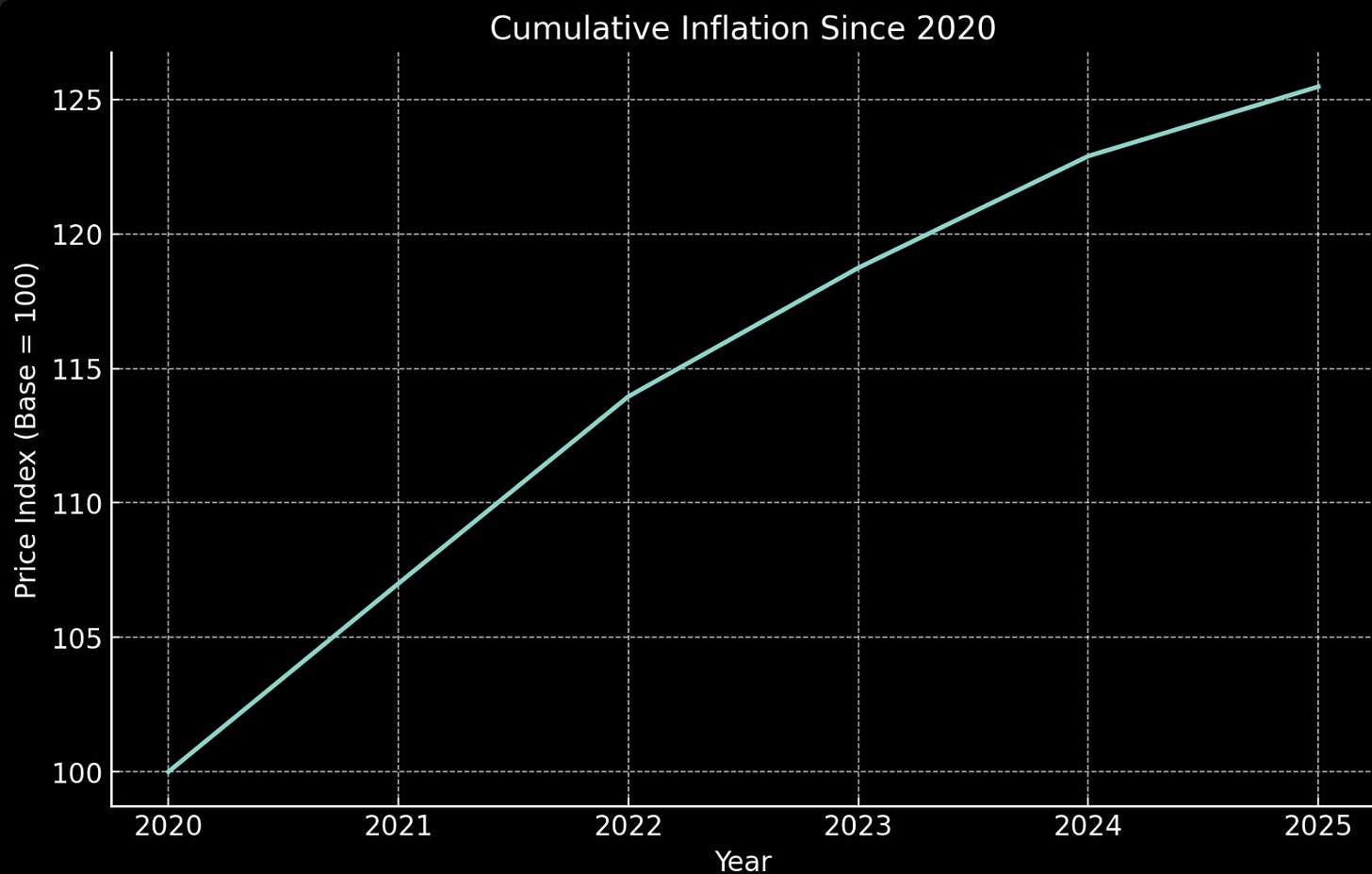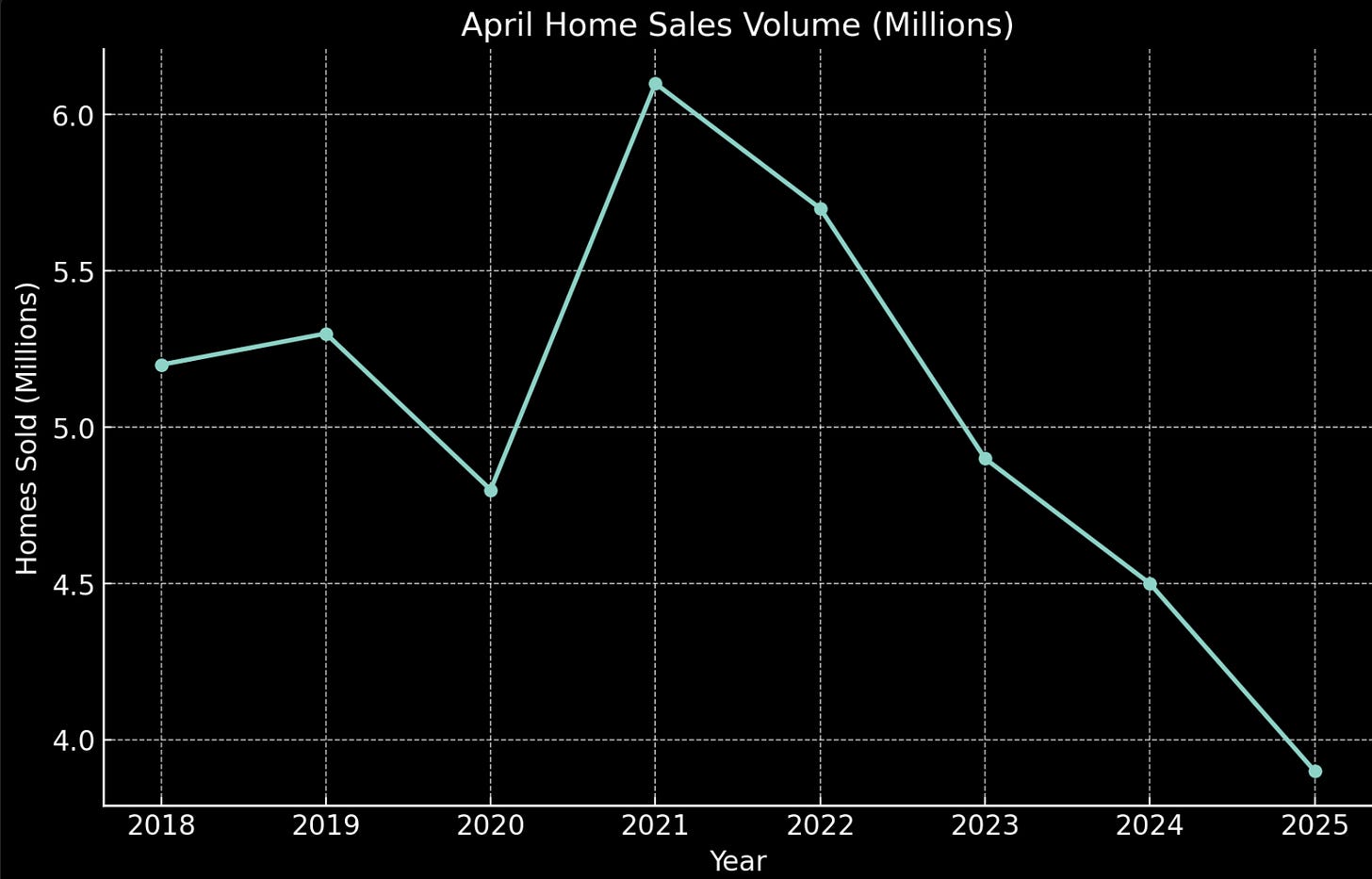Let the games begin.
It’s now been five years since America began its unprecedented monetary experiment—an era defined by stimulus checks, and Federal Reserve intervention. What began in 2020 as an economic lifeline has evolved into a relentless cost-of-living crisis. Inflation is up 25% since 2020. On paper, that’s a 5% average annual rate (reported). In reality, it’s a relentless, compounding erosion of American quality of life.
And like in The Hunger Games, only the most prepared survive.
The Illusion of "Low" Inflation
Friday’s April PCE inflation report— the Federal Reserve metric—came in at 2.1% year-over-year. Markets may now be worried of over tightening by the Fed in the economy. But the reality for consumers is far bleaker. This year-over-year metric fails to account for the cumulative impact of inflation. A one-year snapshot hides the bigger picture: 25% compounded inflation since 2020.
To understand just how severe that is, consider this: the last time America endured a five-year stretch with 5% annual inflation was the 1970s stagflation crisis, when oil shocks, wage controls, and rising unemployment strangled the middle class. Today’s economic parallels are unsettling.
Necessities or Nothing: The Discretionary Collapse
Let’s dissect the most telling inflation reality: where people are still spending—and where they aren’t.
Spending today is focused on survival. The recent inflation breakdown shows that most consumer dollars are going to housing, food, utilities, transportation, and healthcare. These are not lifestyle choices. These are the costs of staying alive.
But when it comes to what people want—the discretionary spending—the cuts are deep and brutal.
Clothing? Down.
Food & Beverage? Down.
Donations to nonprofits? Down.
Financial services? Down.
Americans are systematically cutting out every non-essential expense, not because they want to—but because they have to.
This is the essence of inflation’s damage. Not just a price tag increase, but a quality of life contraction. It’s the economic version of rationing in the arena.
A Nation on Edge: Consumer Sentiment Collapsing
The University of Michigan’s latest Consumer Sentiment Index just plunged to 52—a harrowing sign of economic disillusion. Even more telling: that figure dropped 32% this month alone, triggered by fears over the Trump tariffs and rising living costs. That’s the largest collapse in sentiment since 1990, just before the U.S. slipped into a recession.
Make no mistake—this isn’t a confidence blip. This is economic despair.
The Bottom Lines: Corporate America Feels It Too
Americans aren’t just feeling the heat—they’re changing behavior.
Best Buy slashed guidance this week, citing a “seismic slowdown” in consumer electronics spending. At Kohl’s, the shift is even more stark. Shoppers are “trading down” to cheaper brands. Kohl’s sales dropped -4.1%, translating to a $15 million net loss, and their CEO was shown the door.
Retail isn’t alone. Corporate profits fell nearly -3% in Q1—the largest quarterly decline since Q1 2020. On a year-over-year basis, profits collapsed 27%, the steepest drop since the 2008 financial crisis. These aren’t statistical quirks. This is what it looks like when inflation kills not only purchasing power—but corporate profit engines.
The Housing Crisis: Shelter Becomes a Battlefield
And inflation isn't just hurting consumer spending on discretionary and non-discretionary goods—it’s battering the housing market, too. In April, U.S. home sales dropped to their slowest pace for the month since 2009, when America was deep in the Great Recession.
The culprits are clear: sky-high home prices and crippling 7% mortgage rates. For many, the dream of homeownership is becoming unaffordable. The fallout? Inventory surged 9% month-over-month, and listings are now 21% higher than last April. This isn’t a healthy increase—this is a supply spike fueled by desperation.
Homeowners who can no longer afford rising costs are flooding the market. The result: the highest level of housing supply in five years. Meanwhile, would-be buyers are walking away in growing numbers. Cancellation rates hit 7% of all contracts in April, up from the typical 3–4%, as buyers balk at unaffordable monthly payments or growing recession fears.
This is what economic breakdown looks like in real estate: a game of survival where neither seller nor buyer has the upper hand.
A Trade War Accelerates the Fire
Trump’s new tariffs—rolled out in April—are already slamming global trade. U.S. goods imports fell nearly 20% in April, the largest monthly drop on record. Tariffs are taxes. And while politicians frame them as “America First,” it’s businesses that pay first, passing costs onto consumers or halting trade altogether.
High tariffs → lower imports → lower business activity → lower employment → lower spending.
It's a feedback loop. A dangerous one.
From Districts to Portfolios: How to Survive the Arena
In The Hunger Games, survival doesn't go to the strongest—it goes to the most prepared. The same is now true for your money. This is no longer a market for tourists or optimists hoping for a Fed rescue. In today’s economic arena, only those with a strategy survive.
Chief Market Strategist Greg Crennan of Golden Coast Consultants likens the current environment to walking a tightrope over a pit of fire—where every misstep is punished. According to Crennan, the key to endurance isn’t in chasing risky AI stocks or praying for a soft landing. It’s in playing offense and defense at the same time.
Keep reading with a 7-day free trial
Subscribe to The Coastal Journal to keep reading this post and get 7 days of free access to the full post archives.











